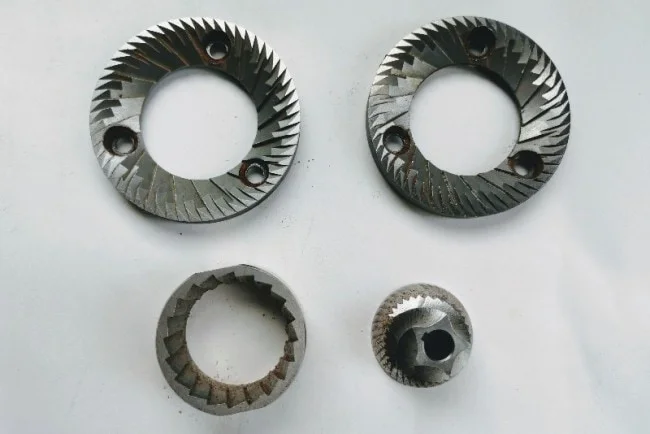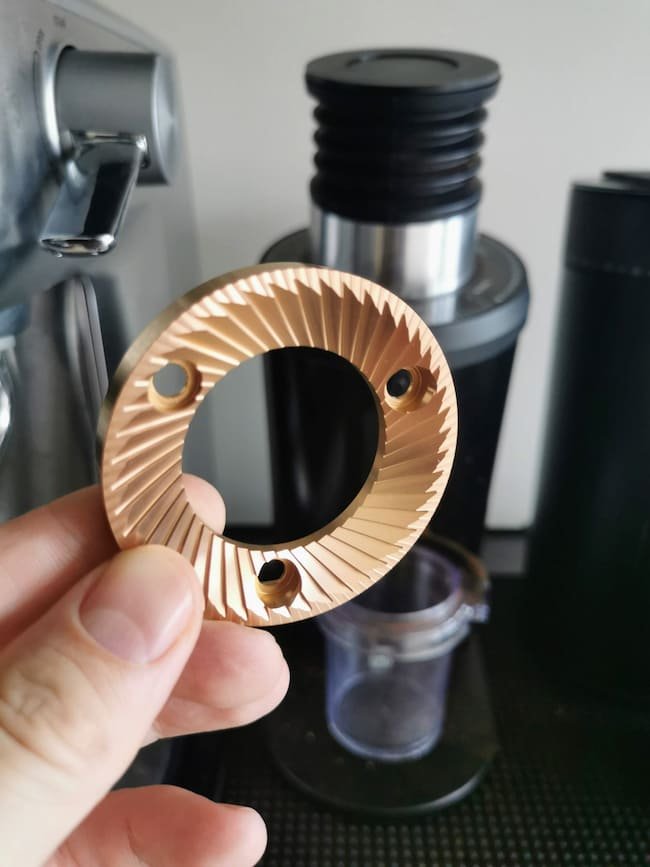Coffee is complicated. Especially when it comes to the myriad of different grinders out there.
You don’t need to research for long before you realize that a burr grinder is the way to roll; blade grinders simply won’t give you a delicious cup of coffee.
But getting a grinder isn’t that simple. You have both conical and flat burr models to consider.
What do these technical differences mean?
And is one better for espresso than the other?
It’s time to get nerdy 🤓
What are conical & flat burr coffee grinders?
The burrs are the primary “crushing/cutting” mechanism that coffee grinders rely on to pulverize whole coffee beans into powder.
Flat burrs are (as the name indicates) flat and have tiny teeth that are used to grind the coffee beans into smaller particles.
Conical burrs have a cone-shaped inner burr that’s spinning and a stationary outer burr.
Both flat and conical burrs can be used for espresso and drip coffee machines. However, some people will argue that one is better than the other, but that’s not really the case. It depends on what kind of coffee you’ll brew and what attributes you value in a grinder. With that out of the way, we can say one sure thing about these grinders: the cheapest burr grinders tend to be conical. In other words; if you’re looking at entry-level grinders, most of them will be equipped with conical burrs. The same goes for hand grinders. Most manual grinders have conical burrs, since it’s very difficult to put big flat burrs into that type of design. So if you value something portable it will usually have conical burrs. Again, this is not necessarily bad. Many hardcore coffee geeks use a manual grinder with conical burrs and absolutely adore it! A burr grinder works on the principle of friction between two surfaces. With a conical burr, each coffee bean has to pass through increasing levels of friction as they get crushed by the rotating burr. The beans are pulled down the increasingly narrow space first by gravity and since by the burr acting like an auger. Eventually, all the coffee beans have to pass through the same slim gap between the inner and outer burr, which means each particle should have a similar diameter. In reality, there will be some variation, however. Often you’ll also get some dust/very tiny particles that are called “fines” in coffee lingo. Flat burrs work a bit differently since they spin at higher speeds. The teeth and the continuous spinning slowly push increasingly smaller coffee chips out towards the grinding chamber’s exit. So that’s a bit of how they work. But which one is better? There are a lot of parameters that we need to look at to answer that question. First and foremost, you should care about grind consistency, aka particle uniformity. Let’s say we grind one scoop of coffee. Maybe half of the scoop will have particles that are 600 microns in size. The rest of the particles will fall in a bell curve shape of smaller and bigger particles. When we talk about things like particle distribution and “peak,” we refer to this curve. Having a high peak and a narrow distribution is usually seen as being desirable. This is because it ensures that most of the particles extract at the same rate. Fines (the dusty, super tiny particles) are usually considered undesirable because they tend to over-extract and create bitterness. They also clog up filters or screens when making pour over coffee, which causes stalling and clogging. If a grinder has two slightly separated peaks, one bigger and one smaller, we call it a bimodal burr grinder when we look at the distribution. If there is only one peak, we call it unimodal. Unimodal is seen as the holy grail for filter coffee, whereas bimodal is regarded as more suitable for espresso. Learn more: How to Clean a Burr Grinder As far as taste goes, bimodal creates a more textured cup with a body sought after by many baristas. On the other hand, unimodal tends to produce a cup with more clarity. This is why many coffee snobs prefer a flat burr grinder for filter coffee. However, there are also many coffee aficionados who prefer flat burrs for espresso since they can offer a more integrated flavor profile with a wider “flavor stage”. It’s also worth noting that some flat burrs, for instance, the hyped SSP Multipurpose set, offer what could be called an incredibly “clean” shot profile with a long aftertaste and high levels of acidity. In contrast, other flat burrs produce a distribution that emphasizes body and sweetness. So even within the world of flat burrs, there can be considerable differences in terms of flavor. Similarly, conical burrs can act differently. There is usually a big difference in terms of clarity when you compare conicals in manual vs electric grinders due to the difference in RPM. The higher power of the electric motor will create more fines. This might be good for espresso, but less desirable for filter coffee. We also need to touch upon grind settings briefly. For espresso and Turkish-style coffees, you want to use a fine grind size. This is where the burrs are super close so that they can produce tiny particles. For French press and drip coffee, you want to use a medium setting. With this grind size, the burrs are set somewhere between fine and coarse. Most (if not all) burr grinders can make a good medium grind. However, it’s usually more challenging to do a very fine or coarse grind since it requires better calibration and precision between each burr. Two important factors when it comes to purchasing a burr grinder are noise and retention. While those factors are crucial, they don’t have much to do with the burr type used in the device. Usually, noise is determined by the material used for the body, the RPM and geometry of the burrs, as well as the overall design. Retention is measured by how much old coffee is retained in the grinder. This is typically stuck in the grinding chamber, chute, or various nooks and crannies of the device. High retention is a problem since it means that there will be some “exchange” every time you grind. In other words, it means that you might get a bit of old coffee out into your portafilter. Using either a flat or conical burr is not the most important aspect of retention. Instead, the overall design of the grinder is far more critical. For instance, the Niche Zero, which is a conical burr grinder, has very low retention. However, the Iberital MC2, another conical burr grinder, has loads of retention. In conclusion, we’ve covered all the major pros and cons of conical vs. flat burr grinders. Depending on your needs and preferences, one option may be more suitable than another. If you’re a first-time buyer looking for something cheap and easy to use, then go for a conical burr. Due to the price, it should probably be the default option for most first-time buyers. You can always upgrade at a later stage if you become obsessed with coffee and are ready to spend more money on a flat burr grinder. On the other hand, if you already know what you want from a grinder, and you’re looking for something ultra-clean and/or high-end, then a flat burr might be the way to go. This question is pretty subjective. There are no right answers here. It depends on your taste preferences. Conical burr grinders tend to create espresso shots with more thickness and texture. They are also found on cheaper grinders than flat burrs, meaning that they are more likely to be your gateway into the world of coffee. It’s hard to say what is best without knowing what kind of coffee you like. If you enjoy sweet-tasting coffees, then go for a cone burr. On the other hand, if your preference leans towards bitter coffees, then go with a flat burr. Yes, conical burrs are worth investing in. They are way better than blade grinders! Also, they are often less expensive than flat burrs, making them a good entry point into the world of grinding. How does burr shape affect your coffee quality?
Grind consistency
Taste differences
Grind Size & Settings
Conical Burrs
Pros
Cons
Flat Burrs
Pros
Cons
Noise & retention
Conclusion
FAQ
I personally favor flat burr grinders because they give me a cleaner cup of coffee with sweetness.
For instance, the cheapest ones are probably the ceramic burr found on many entry-level hand grinders.
The downside is that they can produce a lot of dust, so you need to keep an eye out for that.
You can make delicious coffee using a conical burr, but you’ll need to get some practice.





